MoreorlessMusic
Member
Some of you may remember a question I posed here a month or so ago about a mystery accordion that I saw listed at an auction that had 8 rows of bass buttons that added up to 164, instead of the more usual 120. You kindly identified what the accordion was, a Hohner 5555, and I had a happy time peering at a few examples of them online, two in museums and two on YouTube. I became rather worried about what would happen to the one I saw on the auction site, as it was listed at a "start price" that was very low, and I wondered if someone might buy it as an ornament or, even worse, as something to amuse a delinquent grandchild who enjoyed breaking things, so I bid on it and hoped that the price would go up, and maybe a museum or serious collector would acquire it! I confess that I also hoped that they wouldn't as I had stirrings within me that warned me that I had fallen in love! 
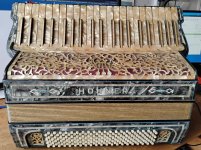
Well, no one else bid on it, so the accordion has come to live with me and become part of my life, and I will be part of its story.
I hoped that I could find out some more about the past 90 years or so of its life, but the person that sold it - it had belonged to her father - knew only that her father had bought it some years ago from someone in Nelson New Zealand, and had played it for a few years before he had a stroke and was unable to continue. Nelson is an interesting area of New Zealand in that I believe that there were quite a few settlers there from Europe around the time of the second World War, and I do wonder if this instrument may have been brought over here by one of them?
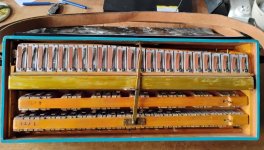
Although almost all the leather valves are curled and stiff, and the reeds are dirty, the accordion has enough voice left to give a tantalising sample of what it did once sound like... it is currently rather like an elderly opera singer who has a throat that is badly affected by tobacco and whos lungs have a touch of emphysema, but they still can move one to tears! The deepest bass notes are rich and gorgeous, and when the treble selectors are juggled so as to select just one set of medium reeds, there moments of beautiful sweetness and clarity.
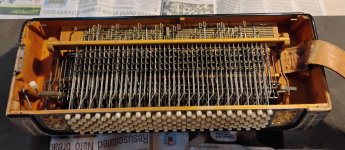
Mostly the accordion is in quite good condition. Thankfully, the bellows work well and just need some re taping in areas that have been in contact with the player. The bass section case must have had some rough treatment at some point in its life and two corners needed gluing and pulling back together. The other two corners also showed some minor cracks internally, so I took care of them before they got any worse. One bass reed was broken, a C4, but I was able to find a replacement for it that had the same size reed plate. This will do the job perfectly well, but it would have been nice to have had an old Hohner reed similar to the original one, but I haven't got any of those thus far in my modest collection of accordion parts.
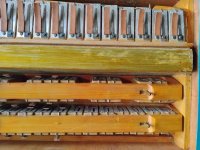
It was nice to have a few simple jobs to attend to right from the beginning, as it was a good way of becoming "introduced" to the Hohner, and an excuse (not that I needed one) to have a jolly good look inside. Here are a few photos to give you an idea of how it is put together. I must say that it is beautifully made and thought out. I love the little levers that you pull to unlatch the reed blocks, so much more convenient than having to hunt for a screwdriver.
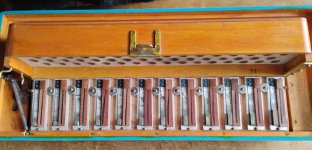
The deepest bass reeds are attached to their block with screws and a leather gasket is used rather than wax. They are big, heavy reeds and the screws keep them in place very well, and I imagine that their firm mounting helps with the transmission of sound from the reed to the structure of the accordion which will help amplify it.

The pallets seem reasonably airtight, I may replace them at some point, but they will do for now.
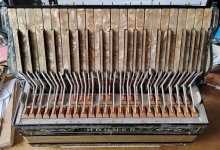
Really most of the work needed is cleaning reeds and giving them new valves and wax. I look forward to doing this progressively as time permits over the next few months.
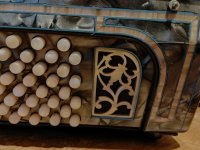
Regarding the bass buttons, with the extra two rows. The outer 6 rows are the usual Stradella type bass arrangement. The inner two rows are arranged chromatically, with the low notes at the bottom, nearest the floor, and the high notes at the top. The range is just over 3 octaves from a low G# to a high B. I have scribbled out a chart for myself to refer to. Of particular interest are points where one can hop onto the "chromatic ladder" of notes, from somewhere well known in the Stradella system. One place I will find useful is from the A counter bass (of Bass F) then you find the chromatic button next to that is also an A. At some point I will do a tiny version of my chart and let you have a look.
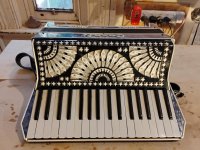
Currently I am repairing and bringing back to playing condition an old accordion for a friend of mine. The accordion is a diminutive 80 bass Casali, a very simple accordion, very humbly constructed out of rather rough and cheap materials. Thus far I have cleaned, re valved, and rewaxed the bass section.... and am now cleaning treble reeds. Maybe one of you will know the year that it was made? (On the top it has the words, "Casali Verona Italia")

Well, no one else bid on it, so the accordion has come to live with me and become part of my life, and I will be part of its story.
I hoped that I could find out some more about the past 90 years or so of its life, but the person that sold it - it had belonged to her father - knew only that her father had bought it some years ago from someone in Nelson New Zealand, and had played it for a few years before he had a stroke and was unable to continue. Nelson is an interesting area of New Zealand in that I believe that there were quite a few settlers there from Europe around the time of the second World War, and I do wonder if this instrument may have been brought over here by one of them?

Although almost all the leather valves are curled and stiff, and the reeds are dirty, the accordion has enough voice left to give a tantalising sample of what it did once sound like... it is currently rather like an elderly opera singer who has a throat that is badly affected by tobacco and whos lungs have a touch of emphysema, but they still can move one to tears! The deepest bass notes are rich and gorgeous, and when the treble selectors are juggled so as to select just one set of medium reeds, there moments of beautiful sweetness and clarity.

Mostly the accordion is in quite good condition. Thankfully, the bellows work well and just need some re taping in areas that have been in contact with the player. The bass section case must have had some rough treatment at some point in its life and two corners needed gluing and pulling back together. The other two corners also showed some minor cracks internally, so I took care of them before they got any worse. One bass reed was broken, a C4, but I was able to find a replacement for it that had the same size reed plate. This will do the job perfectly well, but it would have been nice to have had an old Hohner reed similar to the original one, but I haven't got any of those thus far in my modest collection of accordion parts.

It was nice to have a few simple jobs to attend to right from the beginning, as it was a good way of becoming "introduced" to the Hohner, and an excuse (not that I needed one) to have a jolly good look inside. Here are a few photos to give you an idea of how it is put together. I must say that it is beautifully made and thought out. I love the little levers that you pull to unlatch the reed blocks, so much more convenient than having to hunt for a screwdriver.

The deepest bass reeds are attached to their block with screws and a leather gasket is used rather than wax. They are big, heavy reeds and the screws keep them in place very well, and I imagine that their firm mounting helps with the transmission of sound from the reed to the structure of the accordion which will help amplify it.

The pallets seem reasonably airtight, I may replace them at some point, but they will do for now.

Really most of the work needed is cleaning reeds and giving them new valves and wax. I look forward to doing this progressively as time permits over the next few months.

Regarding the bass buttons, with the extra two rows. The outer 6 rows are the usual Stradella type bass arrangement. The inner two rows are arranged chromatically, with the low notes at the bottom, nearest the floor, and the high notes at the top. The range is just over 3 octaves from a low G# to a high B. I have scribbled out a chart for myself to refer to. Of particular interest are points where one can hop onto the "chromatic ladder" of notes, from somewhere well known in the Stradella system. One place I will find useful is from the A counter bass (of Bass F) then you find the chromatic button next to that is also an A. At some point I will do a tiny version of my chart and let you have a look.

Currently I am repairing and bringing back to playing condition an old accordion for a friend of mine. The accordion is a diminutive 80 bass Casali, a very simple accordion, very humbly constructed out of rather rough and cheap materials. Thus far I have cleaned, re valved, and rewaxed the bass section.... and am now cleaning treble reeds. Maybe one of you will know the year that it was made? (On the top it has the words, "Casali Verona Italia")
